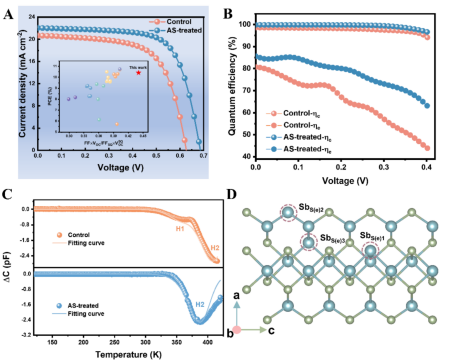NKU Research Team Makes Significant Progress in Sb2(S,Se)3 Solar Cells
Recently, Professor Zhang Yi's research team from Nankai University - College of Electronic Information and Optical Engineering published the latest research results in the field of Sb2(S,Se)3 thin-film solar cells with the title Lowest Open-Circuit Voltage Deficit Achievement to Attain High Efficient Antimony Selenosulfide Solar Cells in the well-known international journal Advanced Functional Materials. The research team achieved the lowest open-circuit voltage deficit for Sb2(S,Se)3 thin-film solar cells reported so far by utilizing a simple and effective surface post-treatment strategy.
Professor Zhang Yi's research team has been dedicated to the study on the preparation and optoelectronic properties of Sb2(S,Se)3 films for many years. They successfully fabricated Sb2(S,Se)3 solar cells via in situ hydrothermal deposition of Sb2S3 films accopanied by post-selenization for the first time in the world (Advanced Electronic Materials 2019, 5, 1800683.), which opened up a new method to fabricate Sb2(S,Se)3 thin-film solar cells. Then, the team adoped sodium selenosulfate first time to replace selenourea, which is comparable to gold in price, as the selenium precursor used in the hydrothermal method of Sb2(S,Se)3 thin films. There were three advantages below: high quality Sb2(S,Se)3 films were successfully prepared, device efficiency reaching the international advanced level for this kind of solar cell, and the fabrication cost being reduced by more than 80% compared to the selenourea system. Moreover, for the first time in the world, the team achieved the regulation of the bandgap of the Sb2(S,Se)3 films in a single-step fabrication process (Small 2023, 19, 2206175.).
Directed by Professor Zhang Yi, Ph. D. candidate Mr. Dong Jiabin conducted in-depth study on Sb2(S,Se)3 solar cells. To address the key issue of large open-circuit voltage deficit in Sb2(S,Se)3 solar cells, they proposed a facile but effective strategy of surface post-treatment with ammonium sulfide ((NH4)2S) solution to tailor the Sb2(S,Se)3 film surface properties. High-quality Sb2(S,Se)3 films were obtained with reduced hole defect types and densities, which helped to suppress the non-radiative recombination and increase the open-circuit voltage. Moreover, the Sb2(S,Se)3 film exhibits an upshifted valence band maximum after AS treatment, facilitating accelerated hole extraction. Consequently, the control device shows a PCE of 8.35%. The AS-treated Sb2(S,Se)3 solar cells demonstrate a higher efficiency of 10.41%. Importantly, the VOC deficit is remarkably reduced to 0.49 V, the lowest values reported thus far for Sb2(S,Se)3 solar cells. Also, the team collaborated with Professor Chen Tao from the University of Science and Technology of China to conduct an in-depth study on the mechanism of open-circuit voltage enhancement. This study provides valuable insight into reducing the open-circuit voltage deficit in solar cells and related photo-electronic devices by suppressing non-radiative recombination.

Figure A: J-V curves of AS-treated Sb2(S,Se)3 solar cells (Comparison: PCE and FFxVOC/FFSQxVOC, SQ of Sb2(S,Se)3 solar cells). Figure B: Carrier transport efficiency and carrier extraction efficiency of corresponding devices under different biases. Figure C: DLTS spectrum of the device. Figure D: Schematic diagram of antisite defects in Sb2(S,Se)3 lattices.
Nankai University is the first completion unit and the corresponding unit of the work. Ph.D candidate Mr. Dong Jiabin from Nankai University - College of Electronic Information and Optical Engineering in Class 2022 is the first author of the paper, and Professor Zhang Yi from Nankai University - College of Electronic Information and Optical Engineering and Professor Chen Tao from the University of Science and Technology of China are the co-corresponding authors.
Paper link: https://doi.org/10.1002/adfm.202309764
(Edited and translated by Nankai News Team.)









